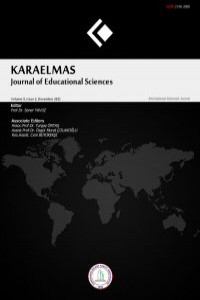Research Article
Systematic Reviews and Meta Analysis
Systematic Reviews and Meta Analysis
1. Ders Araştırması (Ders İmecesi) Modeli Türkiye’de Nasıl Uygulanıyor, Ne İfade Ediyor? : Bir Sistematik DerlemeIssue Editorial Board

Prof. Dr. Soner YAVUZ, 2000 yılında Hacettepe Üniversitesi, Eğitim Fakültesi Kimya Öğretmenliği Lisans programını, 2002 yılında Yüksek Lisansını, 2006 yılında doktorasını yine Hacettepe Üniversitesi, Fen Bilimleri Enstitüsü, Kimya Eğitimi alanında tamamlamıştır.
2001-2006 tarihleri arasında Hacettepe Üniversitesi, Eğitim Fakültesi, OFMA Bölümü, Kimya Eğitimi Anabilim Dalında araştırma görevlisi olarak çalışmıştır. 2006 yılı itibariyle Zonguldak Bülent Ecevit Üniversitesi, Ereğli Eğitim Fakültesinde Öğretim Üyesi (Yrd. Doç. Dr.) olarak çalışmaya başlamıştır. 2011 yılı Eylül ayında Doçent, 2017 yılı Şubat ayında Profesör unvanını almıştır.
Yavuz, şu ana kadar 16 yüksek lisans tezini tamamlatmış, 1 adet yüksek lisans tez çalışmasında danışmanlığı devam etmektedir. Uluslararası indekslerde taranan hakemli dergilerde 23, ulusal indekslerde taranan hakemli dergilerde 9 araştırma makalesi bulunmaktadır. Uluslararası kongrelerde 18, Ulusal kongrelerde 36 bildirisi bulunmaktadır. 6 adet projede (Alt yapı, BAP, Güdümlü Proje, Hibe Proje) yürütücülük ve yardımcı araştırmacılık görevlerini yürütmüştür. Öğretmen yetiştirme, alan eğitimi, kimya eğitimi ve fen eğitimi alanları başlıca araştırma ve çalışma alanıdır.


Aim & Scope
KJES covers articles of original descriptive and experimental research that contain different approaches, applications, qualitative or quantitative methods on all areas of education and compilations. At this point, the aim of the journal is to support and improve the concept of increasing the quality of learning and education in preschool education, primary education, secondary education, higher education and adult education along with the results of research.
Since the scope of the journal cover quite a large area, the headings below can provide information about the related subjects:
Teaching Physical Education and Sports; Religion, Ethics and Values Education; Educational Sciences; Curriculum and Teaching, Educational Management, Supervision and planning, Learning to Think in Education, Educating Teachers, Psychological Counseling and Guidance, Assessment and Evaluation, Designs and Methods of Research, Validity and Reliability, Classical and Disjunctive Evaluation, Developing Scales, Education in Early Childhood; Science Education; Teaching Biology, Teaching Science and Technology, The Nature and Philosophy of Science, Teaching Physics, Teaching Chemistry, Teaching Fine Arts; Teaching Music, Teaching Art, Teaching History of Art, Teaching Mathematics; Teaching Reading and Writing; Educational Technologies; Computer-based Learning Environments, Designing Technoloy and Materials, Distant Education, Web-based Education, Special Education; Educating the Visually Impaired, Educating the Hearing Impaired, Difficulties in Learning, Educating the Mentally Impaired, Education of Social Sciences; Teaching Geography, Teaching Philosophy, Teaching Science of Life, Teaching Psychology, Teaching Social Sciences, Teaching Sociology, Teaching History, Teaching Turkish; Teaching Foreign Language
Author Guidelines
Manuscripts should be submitted in Word in either "doc", "docx" or "rtf" format using a normal, Cambria font single-spaced throughout with upper margins of 2.5 cm, lower margins 1.5 cm, left margins 2 cm and right margins 1.5 cm. Articles should be organized as follows:
Title page:
The title page should include a concise and informative title, the name(s) and complete affiliation(s) of the author(s), and e-mail address. If the article was presented at a scientific meeting, authors should provide a complete statement including date and place of the meeting.
Abstract and key words:
Articles should contain Turkish and English abstracts. Abstracts must be no longer than 300 words. Abbreviations should not be used in the abstract. The authors should list three to five key words which can be used for indexing purposes.
Extended Abstract:
Articles should contain English extended abstracts. Extended abstracts should işnclude 500-700 words. Abbreviations should not be used in the abstract. The authors should list three to five key words which can be used for indexing purposes. Extended abstract covers these sections; 'Purpose and Significance', 'Method', 'Results', 'Discussioın and Conclusion'
Text:
Articles should be organized in four main headings: Background or introduction, method, results, discussion and conclusion. Abbreviations should be defined at first mention in the text and in each table and figure and used consistently thereafter. An "acknowledgement(s)" section may be added following these sections to thank those, if any, who helped the study or preparation of the article. The acknowledgements are placed at the end of the article, before the references. This section contains statements of gratitude for personal, technical or material help, etc.
Citation:
Authors should follow instructions in the current edition (6th) of Publication Manual of the American Psychological Association (APA) for citations. References in the text should be cited by name and year in parentheses.
References:
Authors should follow instructions in the current edition (6th) of Publication Manual of the American Psychological Association for the references. You may visit the following links for APA style:
Basics of APA Style Tutorial; (http://flash1r.apa.org/apastyle/basics/index.htm)
APA Formatting and Style Guide; (http://owl.english.purdue.edu/owl/resource/560/01/)
Mini-Guide to APA 6th for Referencing, Citing, Quoting (http://library.manukau.ac.nz/pdfs/apa6thmini.pdf)
The list of references should be provided at the end of the article, under the title "References", should only include works that are cited in the text and that have been published or accepted for publication. Reference list entries should be alphabetized by the last names of the first author of each work. The author(s) are responsible for the accuracy of the references.
Tables:
Each table must be typed 10 punto Cambria font within the body of main text. Tables should be numbered consecutively with Arabic numerals in order of appearance in the text and should include a short descriptive title typed directly above and essential footnotes including definitions of abbreviations below. They should be self-explanatory and should supplement rather than duplicate the material in the text.
Figures and Graphs:
Figures and graphs should contain headings 10 punto Cambria font. Headings are placed under the figures and objects, center alligned. All figures should be numbered sequentially in the text with Arabic numerals and should be referred to in parentheses within the text. High resolution copies should be sent to ebd@beun.edu.tr via mail, if there is.
Ethical Principles and Publication Policy
SCIENTIFIC RESPONSIBILITY
Authors are responsible for their articles' conformity to scientific rules. Each person listed as an author is expected to have participated in the study to a significant extent. The order of the authors' names must be a joint decision. Corresponding author accepts name order by filling the "Copyright Transfer Form". All authors' names must be included under the article's title. Any individual who does not meet the criteria for authorship but has contributed to the article can be listed in "Acknowledgement(s)" section.
PERMISSIONS
Authors should obtain written permission from the copyright owner(s) for both the print and on-line format if any previously published text passages, tables, figures, etc. are used in the article, and should specify this in the article.
COPYRIGHT TRANSFER
Copyright of an accepted article should be transferred to the Zonguldak Bülent Ecevit University. This transfer covers the exclusive rights to reproduce and distribute the article.
All articles published in this journal are protected by copyright. No material published in this journal may be reproduced in any forms without obtaining written permission from the Editor. Zonguldak Bülent Ecevit University does not accept any legal responsibility for errors, omissions or claims with respect to information published in the journal. "Copyright Transfer Form" must be filled out and sent to ebd@beun.edu.tr . The corresponding author accepts that all information included in the manuscript is complete and has been agreed on by all authors.
Price Policy
Karaelmas Eğitim Bilimleri Dergisi yazarlardan ücret talep etmemektedir.
Indexes
Journal Boards
Editorial and Advisory Board

Editorial Board




2005 yılında Bülent Ecevit Üniversitesi Ereğli Eğitim Fakültesi Sınıf Öğretmenliği bölümünden mezun olmuştur. 2011 yılında Abant İzzet Baysal Üniversitesi Zihin Engellilerin Eğitimi alanında yüksek lisans eğitimini tamamladı. 2007-2013 yılları arasında farklı kurumlarda Zihin Engelliler Sınıf Öğretmeni olarak çalıştıktan sonra 2013 yılında Bülent Ecevit Üniversitesi Özel Eğitim ABD’da araştırma görevlisi olarak göreve başladı. Aynı yıl Gazi Üniversitesi Özel Eğitim Bölümünde doktoraya başlayan araştırmacı 2019 yılında bu programdan mezun oldu. Ulusal ve uluslararası düzeyde bildiri, makale ve kitap bölümleri olan araştırmacı arasında zihin engellilerin eğitimi, öğrenme güçlüğü, öğretmen yetiştirme, üstbilişsel farkındalık, öz düzenlemeli ve öz belirlemeli öğrenme alanlarında çalışmaktadır. Misafir öğretim üyesi olarak Maltepe Üniversitesi ve Medipol Üniversitesinde de dersler vermiş olan araştırmacı halen Zonguldak Bülent Ecevit Üniversitesi Ereğli Eğitim Fakültesi Özel Eğitim ABD’ında Dr.Öğr.Üyesi olarak çalışmaya devam etmektedir.

Prof. Dr. Soner YAVUZ, 2000 yılında Hacettepe Üniversitesi, Eğitim Fakültesi Kimya Öğretmenliği Lisans programını, 2002 yılında Yüksek Lisansını, 2006 yılında doktorasını yine Hacettepe Üniversitesi, Fen Bilimleri Enstitüsü, Kimya Eğitimi alanında tamamlamıştır.
2001-2006 tarihleri arasında Hacettepe Üniversitesi, Eğitim Fakültesi, OFMA Bölümü, Kimya Eğitimi Anabilim Dalında araştırma görevlisi olarak çalışmıştır. 2006 yılı itibariyle Zonguldak Bülent Ecevit Üniversitesi, Ereğli Eğitim Fakültesinde Öğretim Üyesi (Yrd. Doç. Dr.) olarak çalışmaya başlamıştır. 2011 yılı Eylül ayında Doçent, 2017 yılı Şubat ayında Profesör unvanını almıştır.
Yavuz, şu ana kadar 16 yüksek lisans tezini tamamlatmış, 1 adet yüksek lisans tez çalışmasında danışmanlığı devam etmektedir. Uluslararası indekslerde taranan hakemli dergilerde 23, ulusal indekslerde taranan hakemli dergilerde 9 araştırma makalesi bulunmaktadır. Uluslararası kongrelerde 18, Ulusal kongrelerde 36 bildirisi bulunmaktadır. 6 adet projede (Alt yapı, BAP, Güdümlü Proje, Hibe Proje) yürütücülük ve yardımcı araştırmacılık görevlerini yürütmüştür. Öğretmen yetiştirme, alan eğitimi, kimya eğitimi ve fen eğitimi alanları başlıca araştırma ve çalışma alanıdır.
My academic work focuses primarily on language education and teaching Turkish as a foreign language. In my research, I aim to analyze the challenges students face in language learning and develop more effective strategies for education. Additionally, I examine the impact of these strategies on students' writing, listening, and speaking skills, aiming to optimize the learning process.










